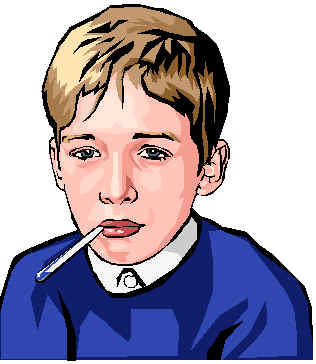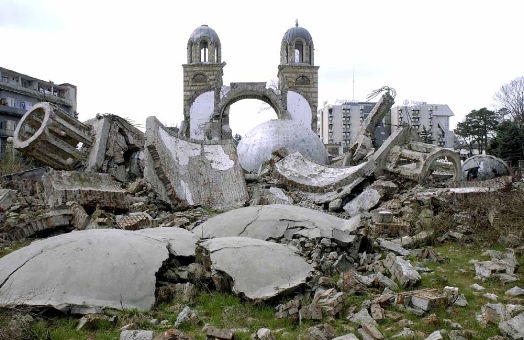V. The Fallout
 As we saw from last time, the Federal Reserve began fueling an unsustainable boom in housing by cutting interest rates to rock-bottom levels beginning in 2001, but eventually had to allow rates to rise back up to contain inflation. As rates began to rise in 2005, a trend which continued up until last year, many adjustable-rate borrowers began to take a hit as their mortgage payments increased. In addition, as rates rose, purchasing new homes became a much less attractive idea. This led to a drop in home prices, making it tougher for short-term borrowers to "flip" their properties as they had originally intended. All of this translated into a surge of foreclosures as banks were forced to recoup what they could as borrowers defaulted.
As we saw from last time, the Federal Reserve began fueling an unsustainable boom in housing by cutting interest rates to rock-bottom levels beginning in 2001, but eventually had to allow rates to rise back up to contain inflation. As rates began to rise in 2005, a trend which continued up until last year, many adjustable-rate borrowers began to take a hit as their mortgage payments increased. In addition, as rates rose, purchasing new homes became a much less attractive idea. This led to a drop in home prices, making it tougher for short-term borrowers to "flip" their properties as they had originally intended. All of this translated into a surge of foreclosures as banks were forced to recoup what they could as borrowers defaulted. Beginning in September of '07, as foreclosures continued to skyrocket and many subprime mortgages (loans given out to lower-income borrowers) went into default, investors who normally purchase mortgage-backed securities began to get cold feet and stopped providing the cash necessary to finance these mortgages . This has led to what the media has referred to as the "liquidity crisis" or "credit crunch." It has become much harder for people to get financing as banks are far more cautious about who they lend to.
As a result of the above developments, there have been massive layoffs across the housing and real estate sector. Many employees hired during the boom period have recently been laid off. The "cluster of errors" I mentioned in yesterday's post are revealing themselves, and the market has begun to prune back these unfruitful investments.
VI. Politicians to the Rescue (Lord Help Us)
 Just this past week, President Bush told the press he's "on top" of the economic situation. The only small problem with this statement is that it's entirely impossible. The president doesn't "control" or "run" the economy. Heck, he hardly even runs his own staff. For him to suggest he's somehow on top of a $10 trillion entity where hundreds of millions of people enter into countless unseen transactions with each other every day is beyond laughable, yet the majority of voters think this way.
Just this past week, President Bush told the press he's "on top" of the economic situation. The only small problem with this statement is that it's entirely impossible. The president doesn't "control" or "run" the economy. Heck, he hardly even runs his own staff. For him to suggest he's somehow on top of a $10 trillion entity where hundreds of millions of people enter into countless unseen transactions with each other every day is beyond laughable, yet the majority of voters think this way.Politicians don't run the economy, and considering all of the damage that government intervention and central planning has been shown to cause, we should certainly be thankful that they don't.
VII. What Bush Can Do
But while the recession is inevitable, there are certain things the President and Congress can do to strengthen the country's long-term economic fundamentals for the future.
1. Call for a large, across-the-board reduction in both income and capital gains tax rates.
This would encourage more risk-taking and would raise returns on investment and work by allowing people to keep more of the fruits of their labor. It would also help keep somewhat of a lid on federal spending by straight-jacketing Congress' spendthrift ambitions.
The Democrats' plan to "soak the rich" (i.e., raise taxes on the people that already pay all of the taxes) doesn't make much sense: it would discourage growth and help finance an even further growth of a federal bureaucracy that's already way too big.
2. Approve drastic reductions in federal spending.
Getting out of Iraq would be nice, as would overhauling entitlements and vetoing any new pork-barrel spending. Freeing up money that would otherwise be spent on bridges to nowhere would be used more productively and efficiently in the private sector.
3. Tell the Fed to keep a tight lid on the money supply.
Inflation corrodes the very seed of economic growth (people's savings) and distorts the calculations entrepreneurs and business owners try to make. Tightening the money supply would slay inflation and preclude the fueling of another unsustainable boom.
4. Unconditionally support free and open trade.
This would unequivocally signal to the rest of the world that the United States is ready to benefit from and contribute to global trade. Welcoming investment and cheap goods from abroad lowers costs and raises living standards; embracing protectionism does just the opposite.
VII. Concluding Thoughts
 As we've seen, recessions aren't necessarily bad things: they are the market's way of correcting the mistakes of government (Fed) intervention so that things can be brought back on an even keel. Think of them as economic "fevers": they serve as a painful but short-lived indication that the free market is doing its job cleansing uneconomic investments so that things can be brought back to normal.
As we've seen, recessions aren't necessarily bad things: they are the market's way of correcting the mistakes of government (Fed) intervention so that things can be brought back on an even keel. Think of them as economic "fevers": they serve as a painful but short-lived indication that the free market is doing its job cleansing uneconomic investments so that things can be brought back to normal.Thus, the best medicine for recessions is to sit back and allow them to run their course. Attempting to inflate the money supply further (which is what the Fed has been doing since August) and handing out "stimulus" checks will only prolong and possibly worsen the hangover's inevitably.
In the meantime, the President and Congress could get to work on the 4 proposals I've outlined above. I won't hold my breath.








